I am completely new to the MVVM pattern, and I've looked all over for information about working with MVVM and SQLite, and I'm still totally lost. I have a project that has several models that populate tables in my database. I have a database service that adds, edits, sets, and gets the objects for and from my tables. The ViewModel has an ObservableCollection of objects, which appear in the View, but how is that updated in my database? So basically, I don't want to populate my ObservableCollection inside of the ViewModel. I want to populate it from the corresponding table in the database. I just don't understand, if the ViewModel's ObservableCollection is being updated from the View, what then updates the information in my Database? To add, the get method in my database service returns the table ToList. I considered trying to do something in my ViewModel like setting the ObservableCollection's property to my get method, but that doesn't work, because one is a list and one is an ObservableCollection. Any thoughts or advice on this would be super helpful. Thanks everybody.
-
Does this answer your question? [Implementing CollectionChanged](https://stackoverflow.com/questions/4588359/implementing-collectionchanged). You add an event handler to CollectionChanged event. In your handler, you do the DB commands. google `c# observablecollection and database example`. – ToolmakerSteve May 22 '22 at 19:46
-
This might actually do the trick. I'm going to play with it a little. If I'm understanding it correctly I could just add anything from the ObservableCollection to my dataTable with a loop that runs any time the collection is changed by the View. Then there would be no need to ever even get the dataTable from the database. I was looking at it from the other way. This makes more sense now. Thank you. – user17195990 May 22 '22 at 20:23
-
*"Then there would be no need to ever even get the dataTable from the database."* Typically, when the app starts (or the user goes to that page), you'll first look in database to see if table has rows. Read those rows and fill your collection. Can do this in page's `protected override void OnAppearing(){ ... }`. So data persists between app sessions. – ToolmakerSteve May 22 '22 at 20:30
-
You got to my second question before I could post it. Thank you. I figured out that I do initially need the database table object in the ObservableCollection, or else nothing is there. But when I added them inside of the ViewModel, my OnCollectionChanged Event created an endless loop of adding the same object. Perfect. I think this is the answer to my question. – user17195990 May 22 '22 at 23:42
-
Great! For future reference, there may be situations where events cause endless loop - I often encounter this when programmatically setting a CollectionView's SelectedItem. The "trick" is to suppress the infinite loop with a flag: `private bool _syncing; ... void SomeMethodThatChangesCollection(){ try { _syncing = true; ...change collection...} finally { _syncing = false; } ... }`, Then `OnCollectionChanged(...) { if (_syncing) return; ...do stuff... }`. – ToolmakerSteve May 22 '22 at 23:46
1 Answers
If I understand the question, you're looking for the two-way glue between the database and the ObservableCollection that your view is bound to. I remember being in that "totally lost" place and wanting an explanation from the ground up in uncomplicated terms and have decided to post a slightly longer-than-usual answer because this is what would have helped me.
If you read though, I will explain how to Insert, Update and Delete records and also query a SQLite local database, displaying the returned recordsets in a ListView like so:
In the beginning your View binding might be something very minimal like this:
<StackLayout>
<ListView ItemsSource="{Binding Recordset}" />
<Grid>
<Button Grid.Column="0"
Text="Query"
Command="{Binding QueryCommand}"/>
<Button Grid.Column="1"
Text="Clear"
Command="{Binding ClearCommand}" />
</Grid>
</StackLayout>
Where the BindingContext has been set like so:
public partial class MainPage : ContentPage
{
public MainPage()
{
BindingContext = new MainPageBinding();
InitializeComponent();
}
}
class MainPageBinding : INotifyPropertyChanged
{
public ObservableCollection<Record> Recordset { get; } =
new ObservableCollection<Record>();
.
.
.
}
And this is going to display a Record/Model that looks similar to this:
[Table("items")]
class Record
{
[PrimaryKey]
public string guid { get; set; } = Guid.NewGuid().ToString().Trim().TrimStart('{').TrimEnd('}');
public string Description { get; set; } = string.Empty;
public override string ToString() => Description;
}
At this point, each and any new Record that we put into Recordset shows up in the view. Specifically, you want to create these records by doing an SQLite query.
public ICommand QueryCommand { get; private set; }
private void OnQuery(object o)
{
Recordset.Clear();
List<Record> queryResult;
using (var cnx = new SQLiteConnection(mockConnectionString))
{
queryResult = cnx.Query<Record>("SELECT * FROM items");
foreach (var record in queryResult)
{
Recordset.Add(record);
}
}
}
Now this is just one approach, right? But I hope it gives you some ideas. I uploaded my working example to GitHub if you'd like to experiment with it.
Now for the other direction.
(This will answer the part of the question if the ViewModel's ObservableCollection is being updated from the View, what then updates the information in my Database?)
Suppose a Description editor pops up so you can edit SelectedItem. When committed it sets the Description property of the SQLite record.
We can simulate that interaction like so:
public ICommand EditCommand { get; private set; }
private void OnEdit(object o)
{
if(SelectedItem != null)
{
// Some kind of UI interaction that changes the bound record
SelectedItem.Description = $"{SelectedItem.Description} (Edited)";
// You'll need to decide what kind of UI action merits a SQL
// update, but when you're ready to do that here's the command:
using (var cnx = new SQLiteConnection(mockConnectionString))
{
cnx.Update(SelectedItem);
}
}
}
Meanwhile we've modified Record to implement INotifyPropertyChanged...
[Table("items")]
class Record : INotifyPropertyChanged
{
[PrimaryKey]
public string guid { get; set; } = Guid.NewGuid().ToString().Trim().TrimStart('{').TrimEnd('}');
public event PropertyChangedEventHandler PropertyChanged;
protected virtual void OnPropertyChanged([CallerMemberName] string propertyName = null)
{
PropertyChanged?.Invoke(this, new PropertyChangedEventArgs(propertyName));
}
string _Description = string.Empty;
public string Description
{
get => _Description;
set
{
if(_Description != value)
{
_Description = value;
OnPropertyChanged();
}
}
}
public override string ToString() => Description;
}
...and since we want the view to update not only on changes to the Collection but to programmatic changes to individual properties we need a data template in the xaml now to properly display the bound Description property:
<StackLayout>
<ListView ItemsSource="{Binding Recordset}"
SelectedItem="{Binding SelectedItem}">
<ListView.ItemTemplate>
<DataTemplate>
<ViewCell>
<Grid>
<Label Text="{Binding Description}" />
</Grid>
</ViewCell>
</DataTemplate>
</ListView.ItemTemplate>
</ListView>
<Grid>
<Button Grid.Column="0"
Text="Query"
Command="{Binding QueryCommand}"/>
<Button Grid.Column="1"
Text="Clear"
Command="{Binding ClearCommand}" />
<Button Grid.Column="2"
Text="Edit"
Command="{Binding EditCommand}" />
</Grid>
</StackLayout>
OK! So Select:
Click the Edit button:
Click the Clear button:
Now click the Query button to confirm that the database is updated.
INSERT and DELETE operations
To ADD a new record:
public ICommand AddCommand { get; private set; }
private async void OnAdd(object o)
{
var result = await App.Current.MainPage.DisplayPromptAsync("New Item", "Describe the item");
if(!string.IsNullOrWhiteSpace(result))
{
var newRecord = new Record { Description = result };
Recordset.Add(newRecord);
using (var cnx = new SQLiteConnection(mockConnectionString))
{
cnx.Insert(newRecord);
}
}
}
To DELETE:
public ICommand DeleteSelectedCommand { get; private set; }
private void OnDeleteSelected(object o)
{
if (SelectedItem != null)
{
var removed = SelectedItem;
Recordset.Remove(SelectedItem);
using (var cnx = new SQLiteConnection(mockConnectionString))
{
cnx.Delete(removed);
}
}
}
SEARCH BAR
To have a comprehensive answer to How does the ViewModel Interact with the Database? requires one more thing: a Search Bar on the main page so we can perform simple queries on the new database: This is the final version of code posted on GitHub.
TO SEARCH:
public ICommand SearchCommand { get; }
private void OnSearch(string expr)
{
Recordset.Clear();
List<Record> queryResult;
using (var cnx = new SQLiteConnection(mockConnectionString))
{
queryResult = cnx.Query<Record>($"SELECT * FROM items WHERE Description LIKE'%{expr}%'");
foreach (var record in queryResult)
{
Recordset.Add(record);
}
}
}
- 5,732
- 2
- 12
- 23
-
1Consider also showing the solution to this sentence in question: **"if the ViewModel's ObservableCollection is being updated from the View, what then updates the information in my Database?"** See the CollectionChanged link I gave in comment on question. – ToolmakerSteve May 22 '22 at 20:32
-
Done! And I wanted to emphasize that editing the Description property changes the `Record` but makes no changes to the `Collection`. The binding that matters is on the model not the list. – IVSoftware May 22 '22 at 22:03
-
Good! That's half of it - property changes. Would also be good to detect collection changes. If UI has commands "Add Item" and "Delete Item", which modify the collection itself, those would trigger `CollectionChanged` event, which should add/delete record in DB. – ToolmakerSteve May 22 '22 at 22:40
-
Thanks for adding `Delete` - Looks Great! I'll keep this answer in mind in case anyone else asks about interacting with DB from XF (or Maui, for that matter - should still apply). P.S. I doubt its a homework question; those are usually in Python or Java. I'll be thrilled if some day we see those in Maui :) – ToolmakerSteve May 23 '22 at 01:43
-





